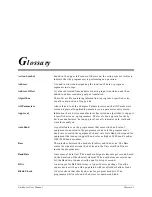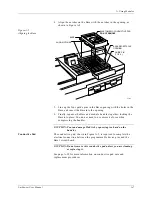
Glossary
Glossary-6
UniSite-xpi User Manual
Logic Verification
After programming a device, you can select test vector verification, fuse
verification, or both types of verification.
Master Device
A device that contains data you wish to program into another device. For
example, you would load data from a master device and then program
that data into a blank device.
MatchBook
A new type of socketing technology that makes handling surface-mount
devices easier.
Memory Begin Address
The first address, in hex, of the first byte of data to be used in device
operations. If the data source/destination is RAM, the memory begin
address is a RAM address. If the data source/destination is disk, the
memory begin address is the offset for a disk file.
Message Bar
The fourth line of the screen. The programmer displays system and error
messages in the message bar. The action symbol is also located in the
message bar.
Next Device
Used during serial set programming, this value specifies the next device
in the set. For example, if you are using 8-bit devices and have specified a
word width of 16 bits, it will require two devices to store each 16-bit
word. Depending on the value entered, the data programmed into the
next device will come from either even addresses or odd addresses.
Non-default Parameters
Also referred to as the Simple Parameter screen, the Non-default
parameters screen displays a selected group of parameters on a
parameter entry screen. To display all the available parameters, select the
All Parameters screen, which is also referred to as the Complex
Parameters screen.
Odd/even Byte Swap
Used during device operations for 16-bit devices, this option swaps the
Most Significant Bytes (MSB) and the Least Significant Bytes (LSB) of 16-
bit words. The programmer stores RAM data and disk file data with the
convention that the LSB of a 16-bit word resides in the even byte of
memory.
Online Help
Available throughout the programmer menus, the help screens provide
you with both general help and context-sensitive help. The Help screen is
divided into four sections: the key listing, the general help, the specific
help, and the reminder bar.
Output Record Size
The number of data bytes contained in each data record during upload.
Overblow
A condition in which fuses are blown that should not have been.
Overblown Fuse
A fuse that has been over-programmed such that the surrounding area
may have been damaged or such that fuse material splatter was created.
Splatter (or rattlers) can cause intermittent shorting.
PAL
An acronym for Programmable Array Logic. PALs are devices with
programmable AND and fixed OR arrays. This is a slightly different
architecture from a PROM or an FPLA. Other examples of PAL-type
architectures from other manufacturers include PEEL and GAL.
Summary of Contents for UniSite-xpi
Page 2: ...981 0014 UniSite Programming System User Manual Also Covering Legacy UniSite Programmers ...
Page 72: ...2 Setup and Installation 2 42 UniSite xpi User Manual ...
Page 134: ...3 Getting Started 3 62 UniSite xpi User Manual ...
Page 238: ...5 Computer Remote Control 5 10 UniSite xpi User Manual ...
Page 296: ...6 Translation Formats 6 58 UniSite xpi User Manual ...
Page 402: ...Keep Current Subscription Service 6 Keep Current ...
















































